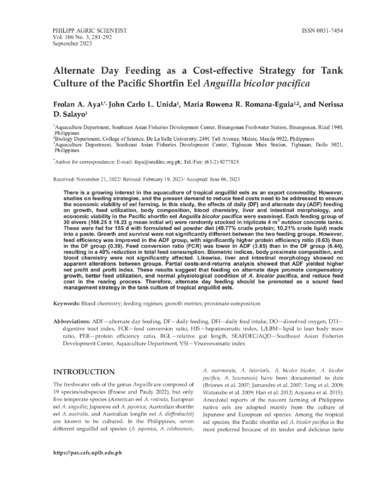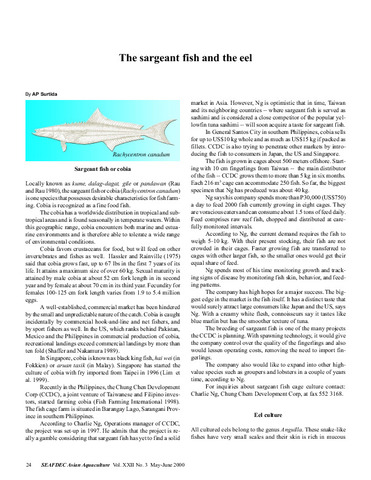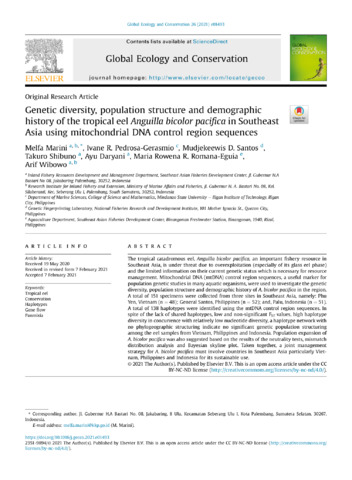Comparison of reproductive aspects of the tropical eel Anguilla bicolor (McClelland 1884) in freshwater and estuarine habitats
Share
| dc.contributor.author | Rachmawati, Farida Nur | |
| dc.contributor.author | Susilo, Untung | |
| dc.contributor.author | Aya, Frolan | |
| dc.coverage.spatial | Serayu | en |
| dc.coverage.spatial | Cilacap | en |
| dc.coverage.spatial | Jawa Tengah | en |
| dc.coverage.spatial | Indonesia | en |
| dc.date.accessioned | 2023-10-23T02:05:36Z | |
| dc.date.available | 2023-10-23T02:05:36Z | |
| dc.date.issued | 2023-09-07 | |
| dc.identifier.citation | Rachmawati, F. N., Susilo, U., & Aya, F. (2023). Comparison of reproductive aspects of the tropical eel Anguilla bicolor (McClelland 1884) in freshwater and estuarine habitats. Ilmu Kelautan: Indonesian Journal of Marine Sciences, 28(3), 260-266. https://doi.org/10.14710/ik.ijms.28.3.260-266 | en |
| dc.identifier.issn | 0853-7291 | |
| dc.identifier.uri | http://hdl.handle.net/10862/6499 | |
| dc.description.abstract | The tropical anguillid eel, Anguilla bicolor McClelland, experiences significant growth up to the adult size in both freshwater and estuarine ecosystems, encountering salinity gradients that may impact their reproduction. Therefore, this study aimed to investigate the reproductive aspects of A. bicolor collected from Serayu River (freshwater) and Segara Anakan (estuary), Cilacap, Central Java, during July 2020 field surveys. The examined parameters included eye index (EI), fin index (FI), gonadosomatic index (GSI), hepatosomatic index (HSI), and sex ratio of eel specimens in freshwater and estuary. Furthermore, the total length (TL) and body weight (BW) ranged from 260 - 630 mm and 18 - 419 g in freshwater, and 260 - 630 mm and 18 - 447 g in estuary. Significant differences (P<0.01) were observed in the reproductive characteristics between the two habitats (P<0.01), with higher eye index, fin index, gonadosomatic index, and hepatosomatic index in freshwater-caught eels than the values obtained in estuary inhabitants. The mean of these four parameters were 6.99 ± 2.98%, 4.08 ± 0.71%, 1.70 ± 1.13%, and 1.92% ± 1.07 in freshwater, while 3.48 ± 1.60%, 3.45 ± 0.479%, 1.12 ± 0.23%, and 0.28 ± 0.19% were found in estuary. The sex ratio was significantly affected by habitat, with female eels dominating in freshwater (62.5%) compared to estuary (32%). These results suggested that eels in freshwater habitats might exhibit early gonadal maturation compared to those in estuary. | en |
| dc.language.iso | en | en |
| dc.publisher | Marine Science Department, Diponegoro University | en |
| dc.relation.uri | https://ejournal.undip.ac.id/index.php/ijms/article/view/55150/pdf | en |
| dc.rights | Attribution-ShareAlike 4.0 International | * |
| dc.rights.uri | https://creativecommons.org/licenses/by-sa/4.0/ | * |
| dc.subject | Anguilla bicolor | en |
| dc.subject | eels | en |
| dc.title | Comparison of reproductive aspects of the tropical eel Anguilla bicolor (McClelland 1884) in freshwater and estuarine habitats | en |
| dc.type | Article | en |
| dc.citation.volume | 28 | en |
| dc.citation.issue | 3 | en |
| dc.citation.spage | 260 | en |
| dc.citation.epage | 266 | en |
| dc.citation.journalTitle | Ilmu Kelautan: Indonesian Journal of Marine Sciences | en |
| dc.subject.asfa | growth | en |
| dc.subject.asfa | sex ratio | en |
| dc.subject.asfa | reproduction | en |
| dc.subject.asfa | migratory species | en |
| dc.subject.asfa | freshwater fishes | en |
| dc.subject.asfa | gonads | en |
| dc.subject.asfa | habitats | en |
| dc.subject.asfa | estuaries | en |
| dc.identifier.essn | 2406-7598 | |
| dc.identifier.doi | 10.14710/ik.ijms.28.3.260-266 | |
| dc.subject.scientificName | Anguilla bicolor | en |
| local.subject | eel | en |
| local.subject | migratory | en |
| local.subject | reproduction | en |
| local.subject | sex ratio | en |
Files in this item
| Files | Size | Format | View |
|---|
This item appears in the following Collection(s)
-
AQD Journal Articles [1215]
These papers were contributed by AQD staff to various national and international journals




